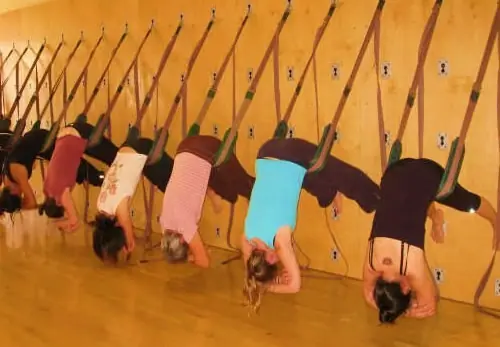What is a Yoga Wall?
The Yoga Wall has been around for decades, originally designed by BKS Iyengar in the form of ropes attached to wall hooks to assist students in various yoga asana (poses). The Great Yoga Wall ? is a newer version of this wall with a system of adjustable straps and more comfortable pelvic swings to accommodate every height and body type. The new system was designed by Kedric Wolfe in the early 80's after he injured his foot on one of the older system's wall hooks. It occurred to him that there must be a "better way" to use the wall with more ease and versatility.
In San Diego, physical therapist and yoga instructor Diana Smith teaches classes and works with clients individually on the Yoga Wall to help improve their overall flexibility and mobility in the spine and joints. Diana describes the benefits of the Yoga Wall as twofold. "It (the Yoga Wall) can help a healthy Yoga practitioner find a new way to access different muscle groups in a pose that they were unable to do without the ropes," she said, "and it can be used therapeutically to help individuals heal from injuries, especially from arthritis and degenerative disc disease."
She says that many of her private physical therapy clients have been able to avoid surgery and recovered from herniated discs with the help of the Yoga Wall.
There are hundreds of poses that can be practiced with the help of the Yoga Wall system. At Embody Yoga and Physical Therapy Centers in San Diego, we teach special sequencing including one called "Rejuvenation of the Spine Series." The series, which is taught by Purna Yoga ? co-founder and Yoga Master, Aadil Palkhivala, incorporates flexion, extension, lateral flexion and rotation all while the spine is in traction. The beauty of the system is that the traction begins at the low back compared to inversion tables which first traction the ankles, knees and hip before reaching the spine. The Yoga Wall uses positioning, action, breath and awareness to open the spine and joints.

Other poses that are practiced on the wall include standing postures, forward bends, back bends, twists and inversions such as headstand, which can be done without any weight on the head.
Long time student and physical medicine physician, Dr. Lance Stone, said he liked it so much, he installed one in his house.
"The Yoga Wall system has enabled me to reach deeper into each pose and experience improved alignment," Stone said. "It is a remarkable tool that has strengthened both my practice and motivation. I feel results that I generally only achieve with a hands-on instructor. It also looks good and doesn't take up much space."
Once you have tried the Great Yoga Wall ?, it is hard to resist coming back. It is unlike anything you have experienced. The only side effect I have seen is a smile that won't go away.


